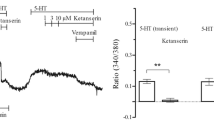Summary
We calculated the contribution of the intracellular releasable calcium pool to the contractile responses induced by 5-hydroxytryptamine (5-HT) and noradrenaline (NA) by constructing time-response curves to the agonists in Ca2+-deficient medium in the isolated rat jugular vein and aorta. Biexponential curves were obtained compatible with a two compartment model. In the aorta the intracellular calcium pools are likely to be different for both 5-HT and NA. Moreover, we investigated the effect of maximally effective concentrations of calcium entry blocking agents (CEB's) on K+, 5-HT- and NA-induced contractions in Ca2+-containing medium. Only a moderate inhibiting effect of nifedipine, diltiazem, flunarizine and gallopamil on 5-HT and NA-induced Ca2+ influx could be observed; in contrast, K+-induced Ca 2+ influx could be antagonized completely. The calculated contribution of intracellular Ca 2+ to 5-HT-and NA-induced contractions, obtained from the experiments in Ca2+-“free” medium was much lower than that obtained after pretreatment with CEB's, leading to the conclusion that after CEB-pretreatment a Ca2+ influx component persists. This hypothesis was supported by the observation that contractions in Ca2+-“free” medium consist of a monophasic, fast response only, whereas after CEB-pretreatment a response similar to the control, including a slow, sustained component, was obtained. The Ca2+ influx component not affected by maximally effective concentrations of CEB's seems to represent an inflow of extracellular Ca2+ directly into the cytosol and not into an intracellular calcium store.
Similar content being viewed by others
References
Auguet H, DeFeudis FV, Clostre F (1984) Competitive inhibition of 5-HT receptors in rabbit isolated aorta by the calcium antagonist methoxyverapamil (D-600). Neurochem Int 6:701–710
Bohr DF (1973) Vascular smooth muscle updated. Circ Res 32:665–672
Casteels R, Droogmans G (1981) Exchange characteristics of the noradrenaline-sensitive calcium store in vascular smooth muscle cells of rabbit ear artery. J Physiol 317:263–279
Cauvin C, Lukeman S, Cameron J, Hwang O, Meisheri K, Yamamoto H, van Breemen C (1984) Theoretical bases for vascular selectivity of Ca2+-antagonists. J Cardiovasc Pharmacol 6:S563–5638
Cohen ML, Wiley KS (1978) Rat jugular vein relaxes to norepinephrine, phenylephrine and histamine. J Pharmacol Exp Ther 205:400–409
Dacquet C, Mironneau C, Mironneau J (1987) Effects of calcium entry blockers on calcium dependent contractions of rat portal vein. Br J Pharmacol 92:203–211
Fleckenstein A (1983) History of calcium antagonists. Circ Res 52 (Suppl 1):3–16
Godfraind T, Kaba A (1972) The role of calcium in the action of drugs on vascular smooth muscle. Arch Int Pharmacodyn Ther (Suppl) 196:35–49
Godfraind T (1981) Mechanisms of action of calcium entry blockers. Fed Proc 40:2866–2871
Gouw MAM, van Zwieten PA (1988) Effect of calcium entry blockade on contractions of venous and arterial smooth muscle preparations of the rat. Naunyn-Schmiedeberg's Arch Pharmacol 337 (Suppl):R53
Heaslip RJ, Rahwan RG (1982) Evidence for the existence of two distinct pools of intracellular calcium in the rat aorta accessible to mobilization by norepinephrine. J Pharmacol Exp Ther 221:7–13
Karaki H, Weiss GB (1988) Calcium release in smooth muscle. Life Sci 42:111–122
Khalil RA, van Breemen C (1988) Sustained contraction of vascular smooth muscle: calcium influx of C-kinase activation. J Pharmacol Exp Ther 244:537–542
Loutzenhiser R, Leyten P, Saida K, van Breemen C (1985) Calcium compartments and mobilization during contraction of smooth muscle. In: Grover AK, Daniel EE (eds) Calcium and contractility. Smooth muscle. Humana Press, Clifton, New Jersey, pp 61–92
Notari RE (1980) Delayed distribution equilibrium models. In: Textbook of biopharmaceutics and clinical pharmacokinetics. Marcel Dekker, Inc, New York, pp 174–179
Owen MP, Joyce EM, Bevan JA (1987) Sources of activator calcium for extrinsic vascular tone and nimodipine inhibition of that tone in proximal vs. distal rabbit ear arteries. J Pharmacol Exp Ther 243:27–34
van Breemen C (1977) Calcium requirement for activation of intact smooth muscle. J Physiol 272:317–329
Wallenstein S, Zucker SL, Fleiss JL (1980) Some statistical methods useful in circulation research. Circ Res 47:1–9
Author information
Authors and Affiliations
Additional information
Send offprint requests to M. A. M. Gouw at the above address
Rights and permissions
About this article
Cite this article
Gouw, M.A.M., Wilffert, B. & van Zwieten, P.A. Effects of calcium entry blocking agents on 5-hydroxytryptamine- and noradrenaline-induced contractions of rat isolated jugular vein and aorta. Naunyn-Schmiedeberg's Arch Pharmacol 339, 533–539 (1989). https://doi.org/10.1007/BF00167257
Received:
Accepted:
Issue Date:
DOI: https://doi.org/10.1007/BF00167257




